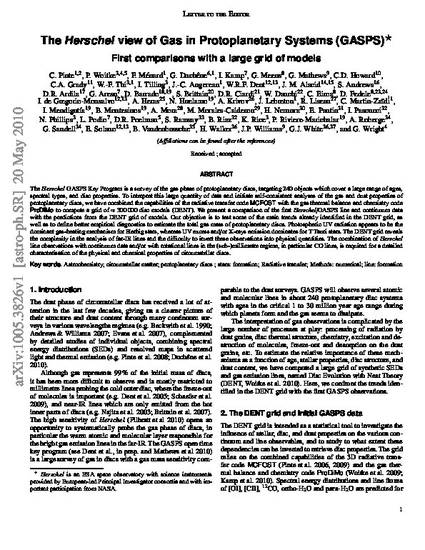
The Herschel GASPS key program is a survey of the gas phase of protoplanetary discs, targeting 240 objects which cover a large range of ages, spectral types, and disc properties. To interpret this large quantity of data and initiate self-consistent analyses of the gas and dust properties of protoplanetary discs, we have combined the capabilities of the radiative transfer code MCFOST with the gas thermal balance and chemistry code ProDiMo to compute a grid of ≈300 000 disc models (DENT). We present a comparison of the first Herschel/GASPS line and continuum data with the predictions from the DENT grid of models. Our objective is to test some of the main trends already identified in the DENT grid, as well as to define better empirical diagnostics to estimate the total gas mass of protoplanetary discs. Photospheric UV radiation appears to be the dominant gas-heating mechanism for Herbig stars, whereas UV excess and/or X-rays emission dominates for T Tauri stars. The DENT grid reveals the complexity in the analysis of far-IR lines and the difficulty to invert these observations into physical quantities. The combination of Herschel line observations with continuum data and/or with rotational lines in the (sub-)millimetre regime, in particular CO lines, is required for a detailed characterisation of the physical and chemical properties of circumstellar discs.

Additional authors: W. Danchi 22, C. Eiroa 8, D. Fedele 8,23,24, I. de Gregorio-Monsalvo 12,13 , A. Heras 25, N. Huelamo 19, A. Krivov 26, J. Lebreton 1, R. Liseau 27, C. Martin-Za¨ıdi 1, I. Mendigut´ıa 19, B. Montesinos 19, A. Mora 28, M. Morales-Calderon 29 , H. Nomura 30, E. Pantin 31, I. Pascucci 32, N. Phillips 3, L. Podio 7, D.R. Poelman 5, S. Ramsay 33, B. Riaz 32, K. Rice 3, P. Riviere-Marichalar 19 , A. Roberge 34, G. Sandell 34, E. Solano 12,13, B. Vandenbussche 35 , H. Walker 36, J.P. Williams 9, G.J. White 36,37, and G. Wright 4
This manuscript has been published in the journal Astronomy & Astrophysics. Please find the published version here (note that a subscription may be necessary to access this version):
http://www.aanda.org/index.php?option=com_article&access=doi&doi=10.1051/0004-6361/201014591&Itemid=129
EDP Sciences holds the copyright in this article.